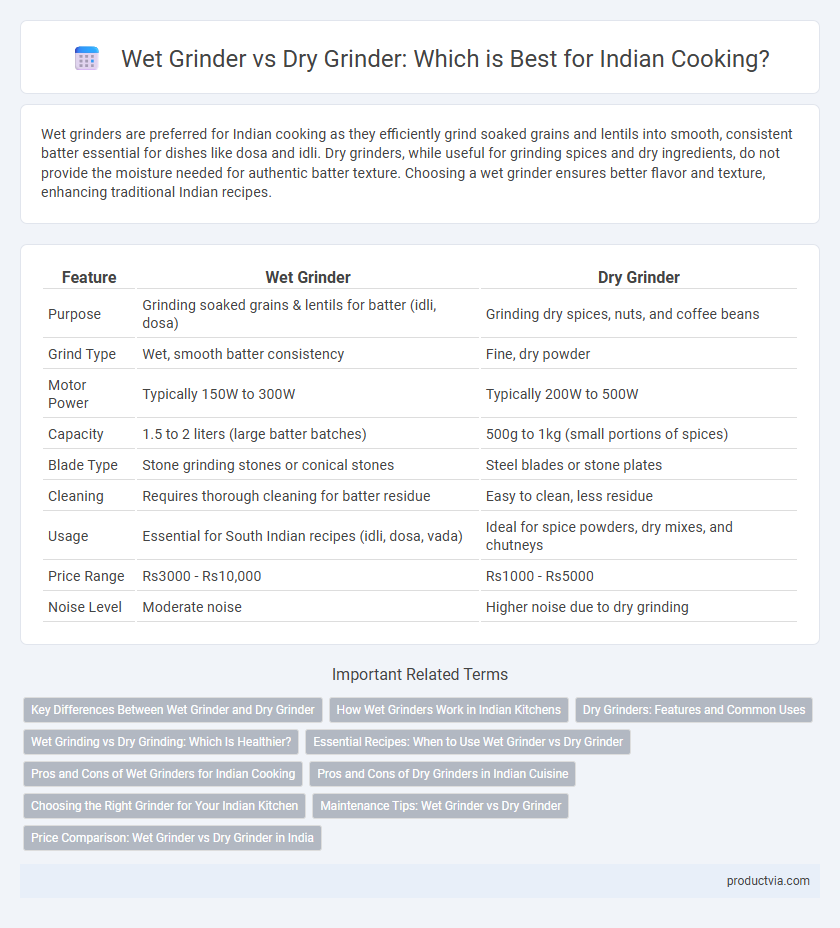Wet grinders are preferred for Indian cooking as they efficiently grind soaked grains and lentils into smooth, consistent batter essential for dishes like dosa and idli. Dry grinders, while useful for grinding spices and dry ingredients, do not provide the moisture needed for authentic batter texture. Choosing a wet grinder ensures better flavor and texture, enhancing traditional Indian recipes.
Table of Comparison
| Feature | Wet Grinder | Dry Grinder |
|---|---|---|
| Purpose | Grinding soaked grains & lentils for batter (idli, dosa) | Grinding dry spices, nuts, and coffee beans |
| Grind Type | Wet, smooth batter consistency | Fine, dry powder |
| Motor Power | Typically 150W to 300W | Typically 200W to 500W |
| Capacity | 1.5 to 2 liters (large batter batches) | 500g to 1kg (small portions of spices) |
| Blade Type | Stone grinding stones or conical stones | Steel blades or stone plates |
| Cleaning | Requires thorough cleaning for batter residue | Easy to clean, less residue |
| Usage | Essential for South Indian recipes (idli, dosa, vada) | Ideal for spice powders, dry mixes, and chutneys |
| Price Range | Rs3000 - Rs10,000 | Rs1000 - Rs5000 |
| Noise Level | Moderate noise | Higher noise due to dry grinding |
Key Differences Between Wet Grinder and Dry Grinder
Wet grinders use water to grind soaked grains and lentils into smooth, batter-like consistency essential for South Indian dishes like idli and dosa, preserving moisture and improving texture. Dry grinders pulverize dry ingredients such as spices and flour into fine powders without moisture, ideal for dry spice blends and flour preparation. The key differences lie in their grinding mechanism, the moisture content in the output, and their specific culinary applications in Indian cooking.
How Wet Grinders Work in Indian Kitchens
Wet grinders use abrasive stones to crush soaked grains and lentils into a smooth batter, essential for dishes like dosa and idli in Indian cooking. These grinders preserve moisture and texture, allowing fermentation and enhancing the taste and nutritional profile of traditional recipes. Their slow grinding process generates less heat, preventing degradation of essential nutrients and ensuring batter consistency.
Dry Grinders: Features and Common Uses
Dry grinders in Indian cooking are designed to grind spices, grains, and lentils into fine powders or coarse textures, providing versatility in preparing masalas and flours. They typically feature high-speed motors, durable stainless steel blades, and multi-grind settings to accommodate varied ingredients like cumin, coriander, and rice. Commonly used for making spice blends, flour for dosa or chapati, and grinding dry pulses, dry grinders enhance flavor and texture while maintaining ingredient freshness.
Wet Grinding vs Dry Grinding: Which Is Healthier?
Wet grinding retains more nutrients in grains and spices, preserving natural oils and enhancing digestibility, making it healthier for Indian cooking. Dry grinding generates heat that can degrade heat-sensitive nutrients and reduce flavor intensity, potentially impacting nutritional value. Choosing a wet grinder supports better nutrient absorption and authentic taste profiles in traditional Indian recipes.
Essential Recipes: When to Use Wet Grinder vs Dry Grinder
Wet grinders are essential for preparing batter-based Indian recipes like dosa, idli, and vada, as they retain moisture and create smooth, consistent textures. Dry grinders excel at grinding spices, grains, and flours, providing fine, powdery results crucial for masalas, chutneys, and besan-based dishes. Choosing the right grinder based on the recipe enhances authenticity, texture, and flavor in traditional Indian cooking.
Pros and Cons of Wet Grinders for Indian Cooking
Wet grinders excel in Indian cooking by efficiently grinding soaked grains and lentils into smooth batter, essential for dishes like dosa and idli. They preserve the natural aroma and nutrients of ingredients while producing consistent, fluffy batter due to their stone grinding mechanism. However, wet grinders require regular cleaning and are heavier and slower compared to dry grinders, which may affect convenience and portability.
Pros and Cons of Dry Grinders in Indian Cuisine
Dry grinders in Indian cooking are ideal for grinding spices and grains with a coarser texture, preserving essential oils and flavors better than wet grinders. They typically require less maintenance and are easier to clean, making them convenient for everyday use. However, dry grinders may not achieve the smooth, fine batter consistency needed for dosas and idlis, limiting their versatility in traditional South Indian recipes.
Choosing the Right Grinder for Your Indian Kitchen
Choosing the right grinder for your Indian kitchen depends on cooking needs and ingredient types. Wet grinders excel at grinding soaked ingredients like rice and lentils into smooth batter for dosa and idli, preserving moisture and texture. Dry grinders handle dry spices, coffee beans, and grains efficiently, providing fine powder without oil release, ideal for spice blends and chutneys.
Maintenance Tips: Wet Grinder vs Dry Grinder
Wet grinders require regular cleaning immediately after use to prevent batter residue buildup, ensuring longevity and hygiene. Dry grinders demand careful maintenance of the blades and thorough dust removal to avoid contamination and maintain efficient grinding. Proper maintenance of both involves routine inspection of parts and avoiding moisture in dry grinders to preserve performance and durability.
Price Comparison: Wet Grinder vs Dry Grinder in India
Wet grinders in India typically range from Rs3,000 to Rs10,000, offering efficient batter grinding ideal for dosa and idli preparation, while dry grinders cost between Rs1,000 and Rs5,000 and are designed for grinding spices and grains to a fine powder. Wet grinders tend to be pricier due to their larger capacity and durable stone grinding plates, which enhance texture and fermentation for Indian cooking. Dry grinders are more affordable and compact but may lack the consistent grinding quality required for wet batter recipes essential in South Indian cuisine.
Wet Grinder vs Dry Grinder for Indian Cooking Infographic

 productvia.com
productvia.com